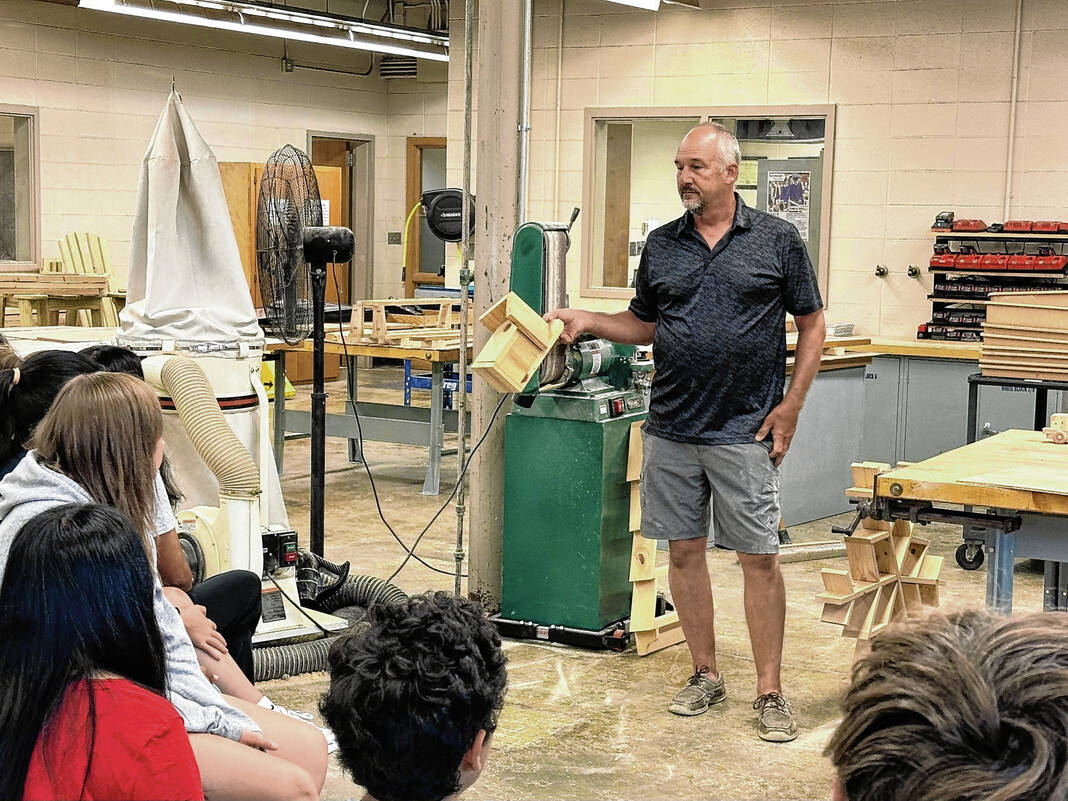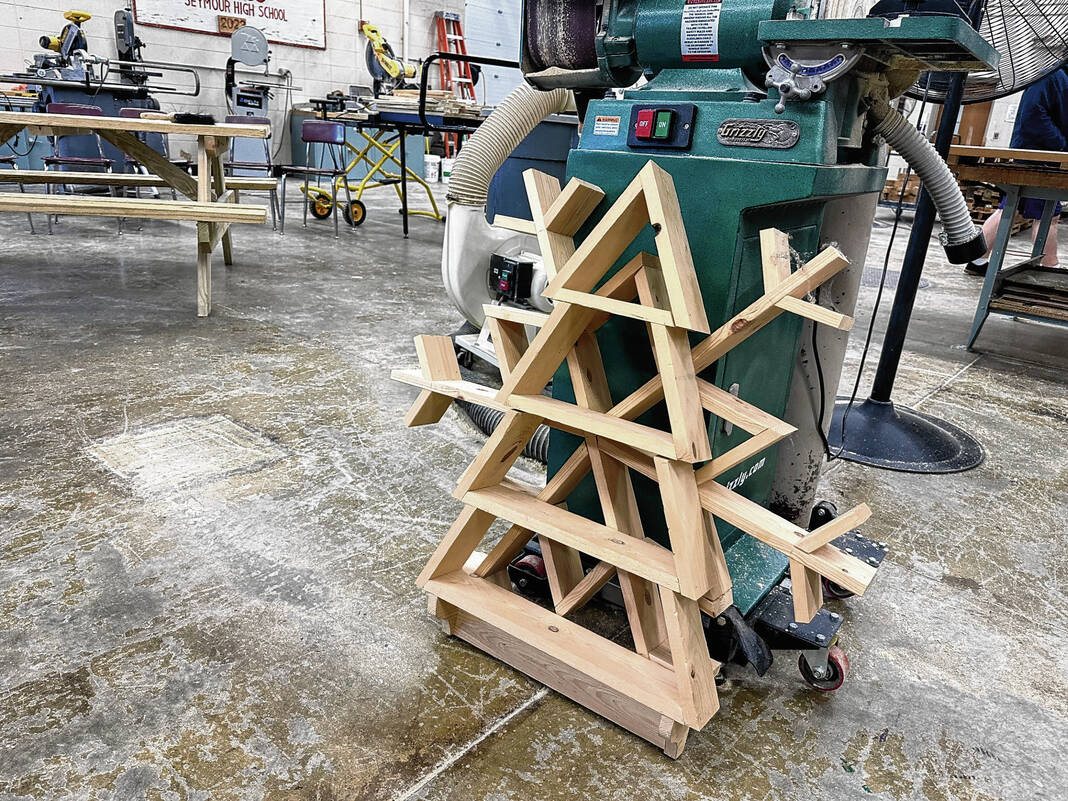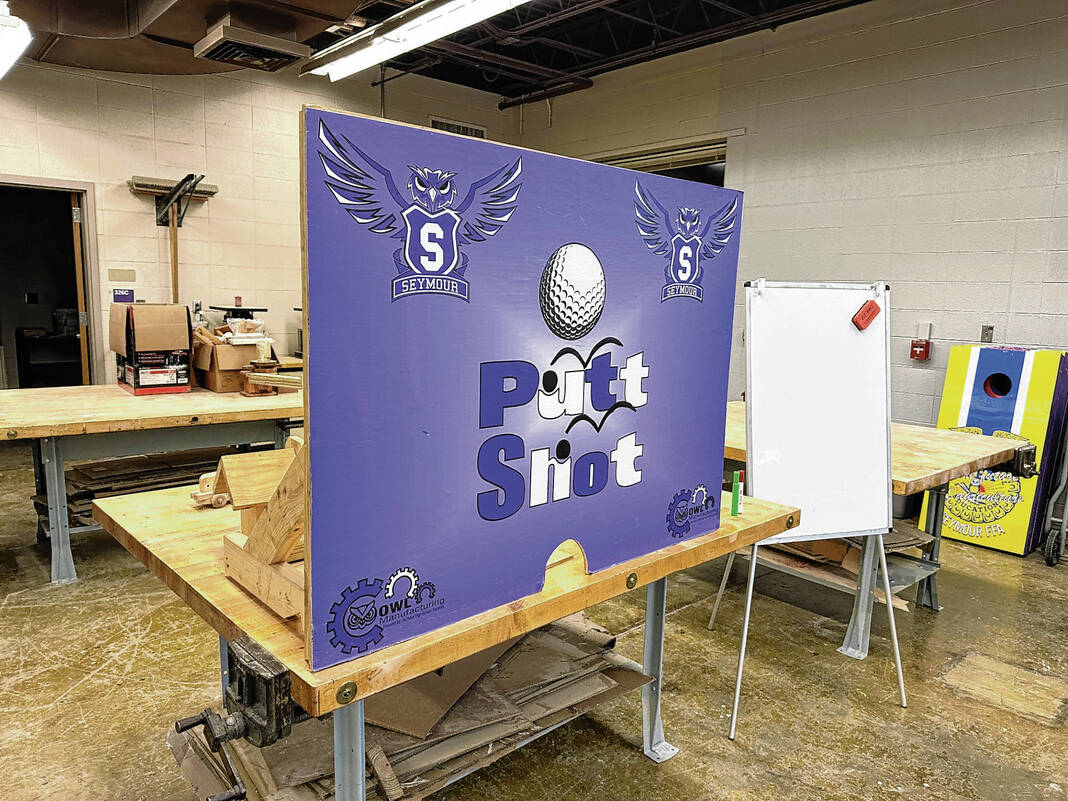
Construction teacher Jerrell Hubbard exhibits a birdhouse to SHS incoming freshman attending this summer’s Preparing for College & Careers class.
Jared Reedy

Second-year SHS construction students construct wooden Christmas trees or snowflakes during the holiday season.
Jared Reedy

Every Friday throughout the school year, students and teachers attempt to make a hole-in-one through this board to win a donut.
Jared Reedy
There are many different pathways for high school students to take on their journey to graduation, and there are numerous avenues for students to pursue on their journey post-graduation. One class at Seymour High School is teaching students just that.
The Jackson County Industrial Development Corporation has partnered with Seymour High School’s Preparing for College & Careers class to provide programming on various topics and bring in guest speakers who educate students on subjects like interviewing skills and finance. The students also take tours of various school departments, such as family and consumer science, Owl Manufacturing, construction trades and agriculture. Students also take trips to different locations around Seymour, such as Pet Supplies Plus and Schneck Medical Center.
Incoming freshmen can take this class in the summer or during the school year. This summer’s class, taught by math teachers Kelly Reasoner and Laura Handloser, kicked off June 3.
Handloser said the class is a good introduction for incoming freshman for what to expect once they are in high school.
“It’s not a very intimidating class, and it provides them a tour of the building and a chance to talk to administrators,” Handloser said. “It gives them an advantage coming in, hopefully already having an A to start off their GPA.”
The class is also a good way for students to realize how many options they have, Reasoner said.
“It’s a good way to introduce all the different pathways to them for graduation,” Reasoner said. “In the summer we’re able to bring in more speakers — we have two hours — so we’re able to take field trips because there’s not other classes going.”
On Tuesday, the class visited Jerrell Hubbard in the construction classroom of the school. Hubbard, who began leading the construction trades program at the high school in 2020, participated in the SHS construction trades program when it was known as building trades. He later attended Vincennes University for construction trades and was in the building supply and construction business in Jackson County for more than 30 years.
Hubbard gave students a rundown on what to expect if they decide to take the three-year program and also spoke on the financial opportunities that arise from pursuing a career in construction.
Hubbard said while the first year for construction students is more classroom-oriented — with some shop experience sprinkled in —second-year construction students go to the school’s construction shop for each class.
The very first project construction second-year construction students undertake is building a birdhouse. Once complete, they can either take it home or let Hubbard nail it to a tree in the woods around his farm.
“My grandkids love to find them; it’s like finding Waldo,” Hubbard said.
Around Christmastime, second-year students build a wooden Christmas tree using power nails. More creatively-inclined students may elect to build a wooden snowflake.
One of the last projects for second-year students involves learning how to lay ceramic tile and building a table.
“I don’t care what you do here; you create your own tile display,” Hubbard told students. “I just want you to do it. It’s about cutting tile and learning how to lay ceramic tile, because that’s another profession in construction.”
Second-year students also learn how to construct walls.
“You will learn to build walls, you will hook up plumbing, you will hook up electric, you will drywall; we’ll put a few rafters up, and then we tear it back down,” Hubbard said.
Third-year construction students partake in “on-the-job” experiences. Students leave the school at noon to work on projects and come back to the school in time for the dismissal bell. Because it is not feasible to have 30 students on a construction site, only 20 third-year students are registered for the class — 10 in each period. School counsellors and Hubbard work together to determine which students will enter the class.
Last year, the third-year construction class constructed a restroom building for the school’s soccer field.
“The foundation and concrete slab was put in last year to start with and we started the third week in August,” Hubbard said. “We worked there until about the third week before the end of school. We did everything over there but the plumbing.”
This year, the third-year construction class is building a shelter house at Redding Elementary School, a horse barn and another shelter house out at Freeman Field.
Hubbard warned students of the varying temperatures and weather conditions they will experience should they choose to pursue construction.
“You’re going to have days when it’s 25 degrees and you’re going to have days where it’s 95 degrees,” Hubbard said, noting that if the temperature is excessively cold or hot he will find something else for the students to do.
Hubbard then described the financial opportunities that arise from working in construction, emphasizing the higher pay construction workers typically earn. He said if any student wants to graduate high school and start laying bricks, they will make at least $75,000 per year starting out. He also said that while some construction professions (such as electricians) require schooling, apprentices are paid to learn their trade in the process of acquiring their licenses.
The importance of learning how to fix household problems yourself — even if one is not interested in construction — was also brought to attention by Hubbard.
“It’s probably $11.50 to replace [a toilet flapper],” Hubbard said. “If you can go to your wall and there’s a shut-off that comes out of the wall where the water comes in, you can turn that, and if you have your wrench that you unscrew something with, you pull [the flapper] out and take an $11.50 part and stick it back in, then turn the water back on. Even if you don’t know how to do it, it’ll take half an hour … A plumber is going to charge $100 to start with to leave her shop, and then she’s going to charge you $30 or $40 an hour … You can do that yourself.”
Next week, the class is visiting Schneck Medical Center to learn about the healthcare industry.
“[This class] lets students know if you’re not a college person, that doesn’t mean you’re not going to have a great career,” Handloser said.
“There’s a lot of opportunities out there and [this class] allows us to bring in the community in and let them tell their stories and their background,” Reasoner said.
